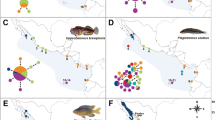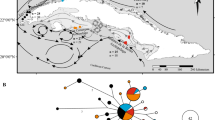Abstract
Allozyme variation at six polymorphic loci was examined in 10 populations of Tridacna maxima from reefs in the Western Coral Sea, to test whether patterns of relatedness previously reported for foraminiferan populations reflected a fundamental structuring of the fauna in the region. Genetic distances (Nei's D) among populations of T. maxima ranged from 0–0.065 and increased with increasing geographical separation. No significant differences in gene frequencies were observed among populations within two groups of reefs identified by cluster analysis: the Great Barrier Reef (GBR), and among the offshore reefs excluding Lihou and Osprey. Significant genetic differences among these groups and the outliers Lihou and Osprey were consistent with the greater geographical separation of populations between areas than within areas. There was no evidence of differentiation along a north-south axis as reported for the foraminiferan Marginopora vertebralis, nor did populations from offshore reefs on the Queensland Plateau form a well-defined group that was genetically distinct from the GBR. The patterns observed for M. vertebralis do not appear to reflect a fundamental structuring of biota in the region. The differences in the pattern of genetic variation for M. vertebralis as compared with those for T. maxima may be due to several differences in the biological characteristics of the two species. The time of breeding in particular may influence the extent to which the divergence of the East Australian Current restricts larval dispersal among reefs in the central Queensland Plateau.
Similar content being viewed by others
References
Andrews JC, Clegg S (1989) Coral Sea circulation and transport deduced from modal information models. Deep-Sea Res 36:957–974
Ayala FJ, Hedgecock D, Zumwalt GS, Valentine JW (1973) Genetic variation in Tridacna maxima, an ecological analog of some unsuccessful evolutionary lineages. Evolution 27:177–191
Benzie JAH (1991) Genetic relatedness of foraminiferan (Marginopora vertebralis) populations from reefs in the Western Coral Sea and Great Barrier Reef. Coral Reefs 10:29–36
Benzie JAH, Stoddart JA (1992) Genetic structure of outbreaking and non-outbreaking crown-of-thorns starfish (Acanthaster planci) populations on the Great Barrier Reef. Mar Biol 112:119–130
Campbell CA, Valentine JW, Ayala FJ (1975) High genetic variability in a population of Tridacna maxima from the Great Barrier Reef. Mar Biol 33:341–345
Church JA (1987) East Australian Current adjacent to the Great Barrier Reef. Aust J Mar Freshwater Res 38:671–683
Copland JW, Lucas JS (1988) Giant clams in Asia and the Pacific. Australian Centre for International Agricultural Research, Monogr 9, Canberra, p 274
Elston RC, Forthofer R (1977) Testing for Hardy-Weinberg equilibrium in small samples. Biometrics 33:536–542
Harris H, Hopkinson DA (1976) Handbook for enzyme electrophoresis in human genetics. North Holland, Oxford Looseleaf
Nei M (1978) Estimation of average heterozygosity and genetic distance from a small number of individuals. Genetics 89:583–590
Nishida M, Lucas JS (1988) Genetic differences between geographic population of the crown-of-thorns starfish throughout the Pacific region. Mar Biol 98:359–368
Pickard GL, Donguy JR, Henin C, Rougerie F (1977) A review of the physical oceanography of the Great Barrier Reef and western Coral Sea. Aust Inst Mar Sci Monogr Ser 2:1–134
Shaklee JB, Keenan CP (1986) A practical laboratory guide to the techniques and methodology of electrophoresis and its application to fish fillet identification. CSIRO Marine Laboratories Report 177. CSIRO, Hobart, p 59
Swofford DL, Selander RB (1981) BIOSYS-1: a Fortan program for the comprehensive analysis of electrophoretic data in population genetics and systematics. J Hered 72:281–283
Waples RS (1987) A multispecies approach to the analysis of gene flow in marine shore fishes. Evolution 41:385–400
Weir BS, Cockeham CC (1984) Estimating F-statistics for the analysis of population structure. Evolution 38:1358–1370
Author information
Authors and Affiliations
Rights and permissions
About this article
Cite this article
Benzie, J.A.H., Williams, S.T. Genetic structure of giant clam (Tridacna maxima) populations from reefs in the Western Coral Sea. Coral Reefs 11, 135–141 (1992). https://doi.org/10.1007/BF00255467
Accepted:
Issue Date:
DOI: https://doi.org/10.1007/BF00255467




